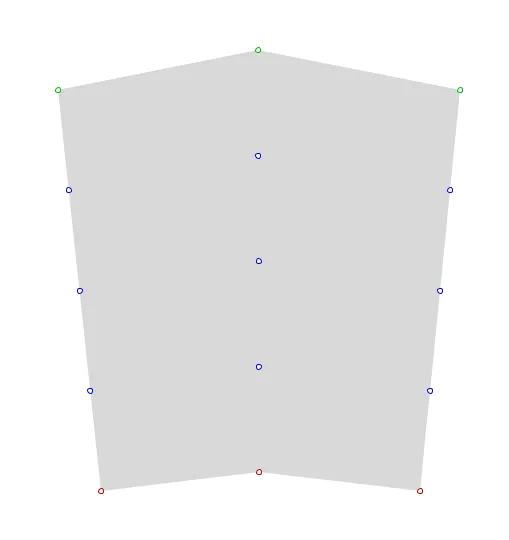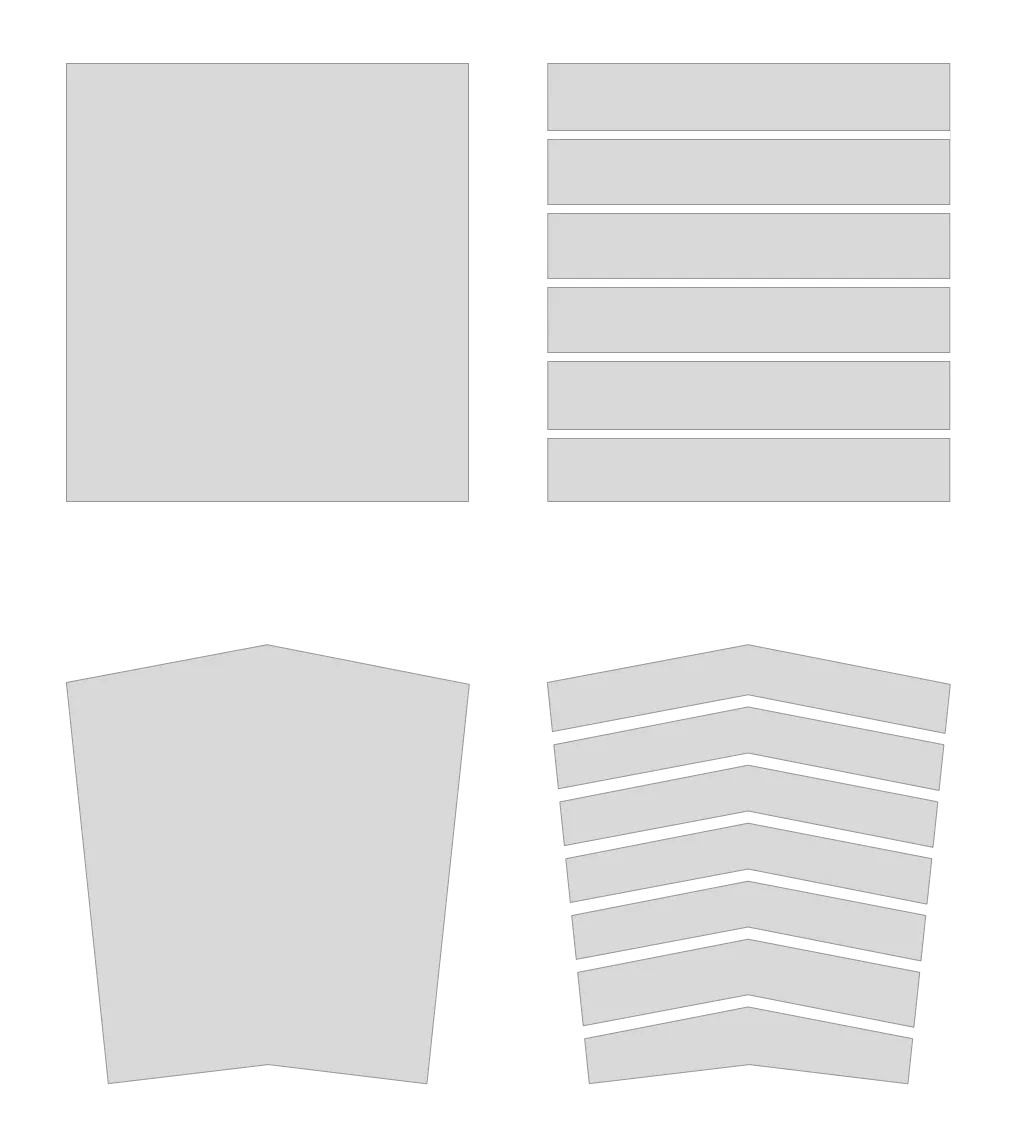这里有一个非常朴素的方法:根据需要划分的行数,在按从左到右排序的顶部和底部顶点之间进行插值。
我已经使用Processing进行了快速测试:
PShape svg,shape;
int divisions = 3;
ArrayList<PVector> top = new ArrayList<PVector>();
ArrayList<PVector> bottom = new ArrayList<PVector>();
int numVerts;
int ptSize = 5;
void setup(){
svg = loadShape("shape.svg");
size((int)svg.width,(int)svg.height);
shape = svg.getChild(0);
numVerts = shape.getVertexCount();
float minY = height,maxY = 0;
for(int i = 0 ; i < numVerts; i++){
PVector v = shape.getVertex(i);
if(v.x < minY) minY = v.y;
if(v.y > maxY) maxY = v.y;
}
float yThresh = (maxY-minY) * .25;
for(int i = 0 ; i < numVerts; i++){
PVector v = shape.getVertex(i);
if(v.y <= minY+yThresh) top.add(v);
if(v.y >= maxY-yThresh) bottom.add(v);
}
PVector last = bottom.get(bottom.size()-1);
PVector first = bottom.get(0);
bottom.set(0,last);
bottom.set(bottom.size()-1,first);
}
void draw(){
background(255);
shape(shape,0,0);
stroke(0,192,0);
for(PVector v : top) ellipse(v.x,v.y,ptSize,ptSize);
stroke(192,0,0);
for(PVector v : bottom) ellipse(v.x,v.y,ptSize,ptSize);
stroke(0,0,255);
float lerpStep = 1.0/(divisions+1);
for(int i = 0 ; i < divisions; i++){
for(int j = 0 ; j < top.size(); j++){
PVector vTop = top.get(j);
PVector vBottom = bottom.get(j);
PVector vLerp = PVector.lerp(vTop,vBottom, lerpStep * (i+1));
ellipse(vLerp.x,vLerp.y,ptSize,ptSize);
}
}
}
void keyPressed(){
if(keyCode == UP) divisions++;
if(keyCode == DOWN) divisions--;
}
这里是 shape.svg:
<?xml version="1.0" encoding="utf-8"?>
<!DOCTYPE svg PUBLIC "-//W3C//DTD SVG 1.1//EN" "http://www.w3.org/Graphics/SVG/1.1/DTD/svg11.dtd">
<svg version="1.1" id="Layer_2" xmlns="http://www.w3.org/2000/svg" xmlns:xlink="http://www.w3.org/1999/xlink" x="0px" y="0px"
width="960px" height="560px" viewBox="0 0 960 560" enable-background="new 0 0 960 560" xml:space="preserve">
<polygon fill="#D8D8D8" points="279,100 479,60 681,100 641,501 480,482 322,501 "/>
</svg>
这里是一个预览,顶部的顶点标记为绿色,底部为红色,插值的顶点为蓝色:

正如@Joseph O'Rourke所提到的,如果底部和底部路径不相似(我猜想是顶点数量和从左到右的顺序不同),那么问题会更具挑战性。在这种情况下,可以实现混合算法(例如
this one)。如果您已经在SVG格式中玩弄各种形状,那么您应该能够通过在
Inkscape或Illustrator中先尝试它来测试混合是否解决了您的问题。
 对于矩形,似乎并不太困难。我卡在如何处理不规则多边形上了。最好有通用的解决方案,特别是如果可以处理曲线,但我可以看出这只会让事情变得更加复杂。是否有任何特定的算法我应该学习?我已经开始深入研究多边形三角剖分以及如何使用耳剪切方法以单调的方式分解这些多边形,但我的头已经开始晕了。PS:不确定是否非常重要,但这些多边形是在SVG中定义的。
对于矩形,似乎并不太困难。我卡在如何处理不规则多边形上了。最好有通用的解决方案,特别是如果可以处理曲线,但我可以看出这只会让事情变得更加复杂。是否有任何特定的算法我应该学习?我已经开始深入研究多边形三角剖分以及如何使用耳剪切方法以单调的方式分解这些多边形,但我的头已经开始晕了。PS:不确定是否非常重要,但这些多边形是在SVG中定义的。 对于矩形,似乎并不太困难。我卡在如何处理不规则多边形上了。最好有通用的解决方案,特别是如果可以处理曲线,但我可以看出这只会让事情变得更加复杂。是否有任何特定的算法我应该学习?我已经开始深入研究多边形三角剖分以及如何使用耳剪切方法以单调的方式分解这些多边形,但我的头已经开始晕了。PS:不确定是否非常重要,但这些多边形是在SVG中定义的。
对于矩形,似乎并不太困难。我卡在如何处理不规则多边形上了。最好有通用的解决方案,特别是如果可以处理曲线,但我可以看出这只会让事情变得更加复杂。是否有任何特定的算法我应该学习?我已经开始深入研究多边形三角剖分以及如何使用耳剪切方法以单调的方式分解这些多边形,但我的头已经开始晕了。PS:不确定是否非常重要,但这些多边形是在SVG中定义的。
i*w距离的描边线,然后构建多边形即可。其中,w为图层厚度,i=0,1,2,3,...。 - Spektre